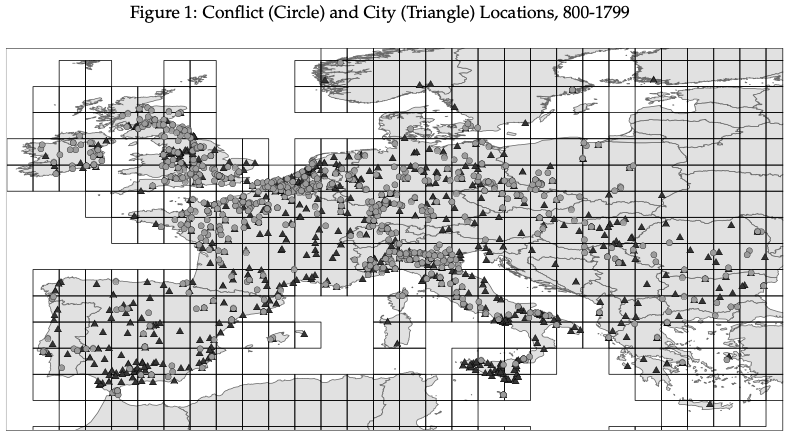War and Urbanization
War and urbanization are surprisingly connected throughout European history

War is father of all, and king of all
Heraclitus
The question of how Europe overtook other world regions in development during the last 500-700 years and came to dominate the world has occupied many minds and is constantly returning to the scholarly agenda. Was it an accident, a geographical predetermination or an institutional feature? In attempts to address this issue, many individual processes or phenomena have been found that characterize Europe differently from other parts of the world. The article we discuss today [1] analyzes two such features: the huge number of military conflicts and rapid urbanization, and finds a strong link between them (and even establishes causality).
First, the authors prepare the data. A map of Europe is divided into 150x150 km2 cells. All cities that existed between 800 and 1799 (676 in total) and all battles (847 in total) are plotted on the same map.

Next, a simple linear regression (that is, a linear law relating the population of a particular city to whether or not at least one battle occurred in its cell) is compiled, which demonstrates that cities prone to armed conflict grew 6-11% per hundred years faster than calmer cities. To appreciate the magnitude of the effect, we note that the average growth rate of cities in Europe between 800 and 180 years was about 22%.
The problem with this interesting result lies in the limited time period and geographic region. It is difficult to imagine that an ongoing war in Ukraine would lead to increased local urbanization. There is no comparison of urbanization in the New World or Australia, where there have been far fewer military conflicts. While the link established is interesting in its own right, the underlying cause remains undiscovered - what is the reason for the belligerence of Europeans?
[1] Dincecco, M., & Onorato, M. G. (2016). Military conflict and the rise of urban Europe. Journal of Economic Growth, 21, 259-282.



Comments ()